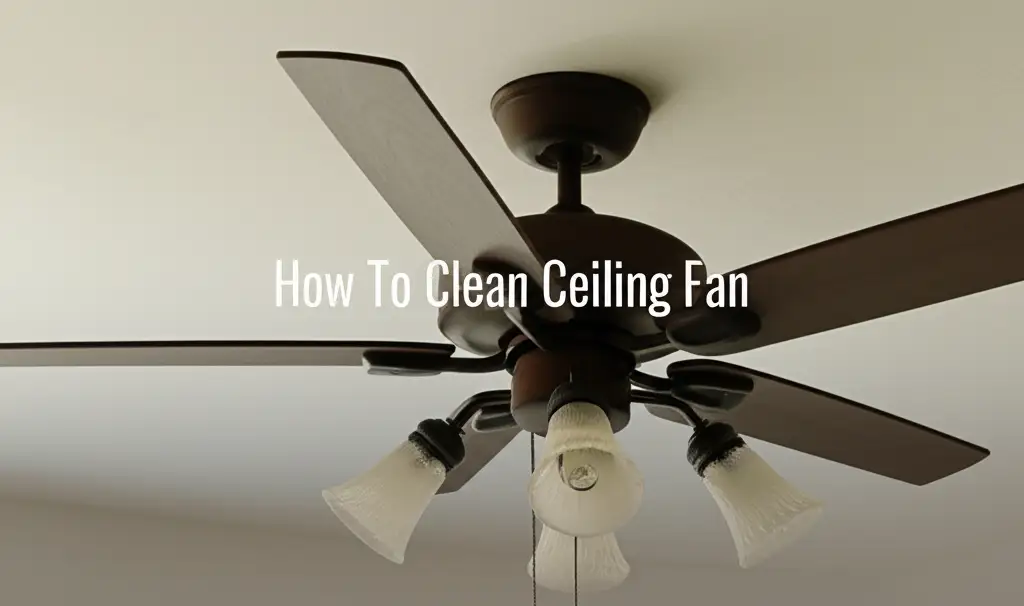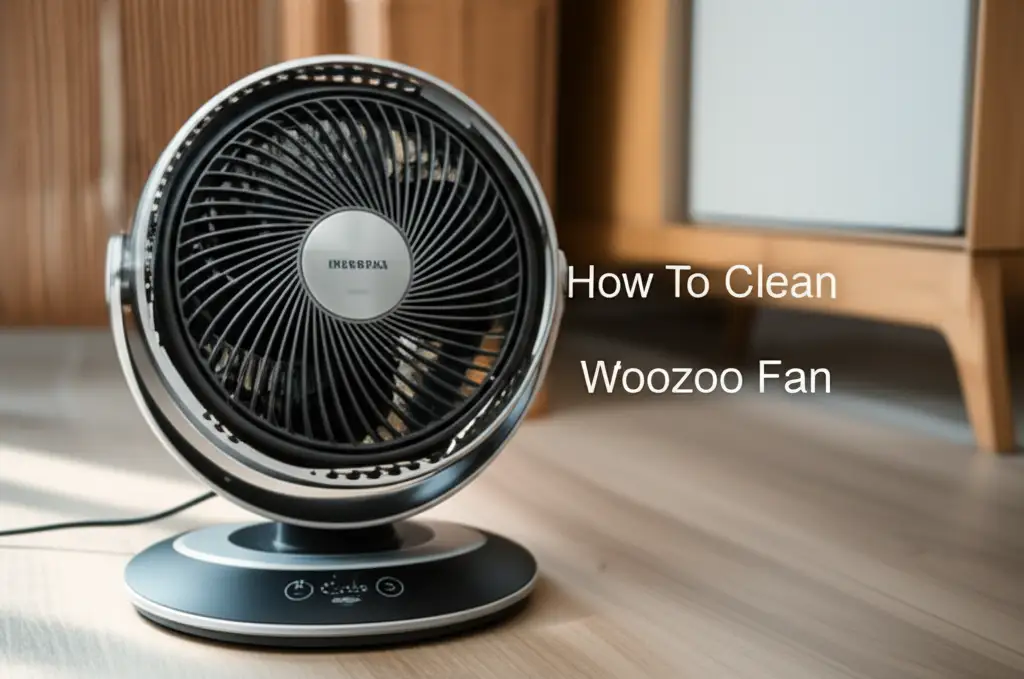· Home Cleaning · 10 min read
How To Clean Ceiling Fan

Mastering How To Clean Ceiling Fan for a Spotless Home
Ceiling fans offer cool comfort and circulate air in our homes. Over time, these helpful appliances collect dust, grime, and even grease, becoming less efficient and looking dirty. A dirty ceiling fan also spreads dust around your living space. Learning how to clean ceiling fan parts properly helps your home feel fresher and cleaner.
This guide will walk you through easy steps to clean your ceiling fan. We will cover preparing for the task and cleaning fan blades, motor housing, and light fixtures. You will also learn about special techniques for tackling greasy fans or those in high places. My goal is to make your cleaning process simple and effective, ensuring your fan runs smoothly and looks great. Let’s get your ceiling fan sparkling.
Takeaway:
- Gather all cleaning supplies before you start.
- Prioritize safety by turning off power and using a stable ladder.
- Use a pillowcase to capture dust from fan blades effectively.
- Clean motor housing and light fixtures with appropriate tools.
- Address greasy fans with specialized degreasers.
- Perform regular maintenance to keep fans cleaner longer.
To clean a ceiling fan, first turn off the power at the wall switch or circuit breaker for safety. Gather a pillowcase, cleaning cloths, a mild all-purpose cleaner, and a stable ladder or extendable duster. Carefully wipe each blade using the pillowcase method to trap dust, then clean the motor housing and light fixtures.
The Importance of Regular Ceiling Fan Cleaning
Keeping your ceiling fan clean is more than just about appearances. A dusty fan can circulate allergens throughout your home. This impacts indoor air quality, which affects your family’s health. Regular cleaning helps reduce dust mites and other airborne particles.
Dirty fans also work harder to move air. Dust accumulation on blades creates drag, meaning the motor uses more energy. This can increase your electricity bills. A clean fan operates more efficiently, saving you money and extending its lifespan. I always feel better knowing my appliances are running at their best.
Moreover, a well-maintained ceiling fan looks much nicer. It enhances the overall cleanliness and appearance of any room. Nobody wants to look up and see thick layers of dust on their fan blades. Regular cleaning brightens your space and makes your home feel more inviting.
Essential Tools and Supplies for Cleaning Your Ceiling Fan
Before you begin cleaning, gather all the necessary tools. Having everything ready saves time and makes the process smoother. You will need a few simple items that you likely already have around your house. Prepare your workspace for an efficient clean.
First, safety is key. A sturdy stepladder or ladder is important to reach the fan safely. Make sure it is stable on a flat surface. You might also want a drop cloth or old sheet to place under the fan. This catches any falling dust or debris, making cleanup easier.
Next, for cleaning the fan blades, a pillowcase is a secret weapon. It helps contain dust effectively. You will also need microfiber cloths for wiping surfaces. A spray bottle filled with a mild all-purpose cleaner or a mix of water and white vinegar works wonders. For tougher grime, a degreaser might be necessary, especially for kitchen fans. Sometimes, a duster with an extendable handle is useful for initial dust removal or for reaching fans without a ladder. Discover more ways to clean a ceiling fan without a ladder.
Safety First: Preparing for Ceiling Fan Cleaning
Safety must be your top priority when cleaning a ceiling fan. Working with electricity and at heights carries risks. Taking proper precautions prevents accidents and ensures a safe cleaning experience. Never rush this important step.
Always start by turning off the power to the ceiling fan. You can do this at the wall switch. For extra safety, I recommend flipping the corresponding breaker in your home’s electrical panel. This prevents anyone from accidentally turning the fan on while you are working. Confirm the fan is completely off before touching it.
Once the power is off, position your ladder securely directly under the fan. Ensure all four feet of the ladder are on a stable, flat surface. Have someone spot you if possible, especially for taller ladders or high ceilings. This extra pair of eyes provides stability and peace of mind. Prepare to catch dust by placing a drop cloth or old newspaper on the floor below the fan. If your fan is particularly high, consider reading tips on how to clean a high ceiling fan effectively and safely.
Step-by-Step Guide to Cleaning Ceiling Fan Blades
Cleaning the blades is often the most impactful part of the process. This is where most dust accumulates. The pillowcase method is incredibly effective for this task. It helps keep your floor clean.
The Pillowcase Method
Start with one fan blade. Carefully slide an old pillowcase over the entire blade, from the base to the tip. As you pull the pillowcase back towards you, the dust will fall directly into the case. This simple trick prevents dust from scattering everywhere. Repeat this process for each blade until they are all free of loose dust. I find this method saves a lot of cleanup later.
After removing the bulk of the dust, use a damp microfiber cloth to wipe down each blade. You can lightly spray the cloth with an all-purpose cleaner or a water-vinegar solution. This removes any remaining grime or sticky residue. Make sure to wipe both the top and bottom surfaces of each blade. For stubborn spots, a gentle scrub might be needed. If you are specifically trying to remove dust, remember these general tips on how to clean dust off a fan efficiently.
Cleaning the Motor Housing and Light Fixtures
Once the blades are spotless, turn your attention to the fan’s motor housing and any integrated light fixtures. These areas also collect dust and grime. Cleaning them ensures your entire fan looks clean and functions well. This step adds to the overall sparkle of your fan.
For the motor housing, use a dry or slightly damp microfiber cloth. Gently wipe down all surfaces. Pay attention to vents or crevices where dust might settle. A small, soft brush can help dislodge dust from hard-to-reach spots. Avoid spraying cleaner directly onto the motor housing, as moisture can damage electrical components. Simply wipe carefully.
If your ceiling fan has light fixtures, clean them next. Remove any glass globes or covers if they are easily detachable. Wash these in warm, soapy water, rinse them well, and let them air dry completely before reattaching. For bulbs, simply wipe them gently with a dry or slightly damp cloth to remove dust. Ensure all parts are completely dry before restoring power to the fan. This also applies when you need to clean greasy ceiling fans, where a more thorough cleaning of lights might be needed.
Special Cleaning Scenarios: Greasy or High Ceiling Fans
Some ceiling fans present unique cleaning challenges. Fans in kitchens often accumulate grease, while those in rooms with high ceilings require different access methods. Knowing how to handle these situations makes your cleaning task easier and safer. Do not let these challenges deter you.
Tackling Greasy Ceiling Fans
Kitchen ceiling fans are prone to collecting a sticky, greasy film mixed with dust. Standard cleaners might not cut through this effectively. For greasy fans, I recommend a degreaser spray. Apply the degreaser to a microfiber cloth, not directly to the fan. Then, wipe down the blades and motor housing. For very stubborn grease, let the degreaser sit for a few minutes before wiping it off. You may need to repeat this process. This method helps to effectively clean grease off a ceiling fan and surrounding areas. Always rinse with a clean, damp cloth afterwards to remove any degreaser residue.
Cleaning High Ceiling Fans
Reaching fans on high ceilings requires specialized tools or methods. A tall, sturdy extension ladder is one option, but always ensure it is stable and used safely. Alternatively, an extendable duster with a flexible head can reach high blades. Some dusters have a specific shape to fit over fan blades, making it easier to capture dust. While these tools are good for light dust, a thorough clean still usually requires direct access. Remember to still turn off the power for safety, even when using an extendable tool.
Maintaining Your Ceiling Fan: Regular Care Tips
Cleaning your ceiling fan is not a one-time event. Regular maintenance keeps it looking good and performing efficiently. Incorporating simple habits into your cleaning routine will prevent heavy dust buildup. This makes future cleaning sessions much easier.
Aim to dust your ceiling fan at least once every few months. For high-traffic areas or homes with pets, consider dusting monthly. A quick pass with an extendable duster can keep surface dust at bay between deep cleans. This prevents dust from baking onto the blades, which makes cleaning much harder later. I find that quick, frequent dusting is better than a big, infrequent scrub.
Another tip is to check the fan blades for balance periodically. If a blade seems wobbly, it might not be secured properly. Tighten any loose screws. Also, ensure the fan is running smoothly without unusual noises. Addressing minor issues quickly can prevent bigger problems down the line. Keeping your fan clean and well-maintained helps it last longer and continue providing comfort.
FAQ Section
How often should I clean my ceiling fan?
You should clean your ceiling fan at least once every three to four months. If your home has pets, or if someone has allergies, clean it more often, perhaps monthly. Regular dusting prevents heavy buildup.
Can I use household cleaners on my ceiling fan?
Yes, you can use mild household cleaners. A mixture of equal parts white vinegar and water works well. You can also use a general all-purpose cleaner. Always spray the cleaner onto a cloth first, not directly onto the fan, to avoid moisture damage.
What is the best way to remove dust from fan blades without making a mess?
The pillowcase method is the best way. Slide an old pillowcase over each blade and pull it back, trapping the dust inside. This prevents dust from falling onto your furniture and floor, making cleanup much easier.
Is it safe to clean a ceiling fan while it’s on?
No, it is not safe to clean a ceiling fan while it is on. Always turn off the power to the fan at the wall switch. For added safety, consider turning off the corresponding circuit breaker before you begin cleaning.
How do I clean a sticky or greasy ceiling fan?
For sticky or greasy ceiling fans, especially in kitchens, use a degreaser. Spray the degreaser onto a microfiber cloth. Wipe the blades and motor housing thoroughly. You might need to let the degreaser sit for a few minutes on stubborn grease. Rinse with a clean, damp cloth.
Conclusion
You now know how to clean ceiling fan parts, from dusty blades to greasy motor housings. Keeping your ceiling fan clean offers many benefits, including better air quality, increased energy efficiency, and a more attractive living space. By following these simple steps, you can maintain your fan’s performance and appearance with ease. Remember to prioritize safety by turning off the power and using a stable ladder.
Regular maintenance is key to a long-lasting, efficient fan. Make ceiling fan cleaning a part of your regular home maintenance routine. A clean fan not only looks better but also contributes to a healthier and more comfortable home environment. Enjoy the fresh air and improved efficiency of your sparkling clean ceiling fan.
- ceiling fan cleaning
- dust removal
- fan maintenance
- home cleaning tips
- clean fan blades
- greasy fan




